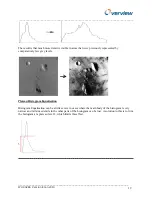
__________________________________________________________________________________
__________________________________________________________________________
IPU 40285 Version E Jan 2013
18
It is common to find that the image background retains its contrast (which could be an advantage over
the median scheme), and small hot targets appear completely white, which makes them easy to detect.
The hotter and smaller they are, the more likely they are to be completely white, with little colour
contrast across the target, for exa
mple on people’s faces. As the hot target increases in size (perhaps
by moving closer to the imager), the mean moves towards the mid point of the two modes of the
bimodal histogram. In this case the background has to make do with fewer colours to represent itself
whilst the target gains colours, and more detail can be seen.
This is a useful histogram to demonstrate the limitations of linear contrast schemes such as the median
and mean schemes. The colours assigned to intensities between the two histograms are unused. If the
foreground and background are at very different temperatures this becomes a significant waste of
display colours.
A similar problem occurs if the majority of the image is in a small range. Using a linear contrast
scheme will show little contrast in the majority of the image.
Histogram Equalisation
Histogram Equalisation attempts to solve this problem by displaying a more even number of pixels
with each available grey level. For example the histogram of an image with most of the pixel
intensities in the darker end of the greyscale can be transformed so that the colours are distributed
more evenly.
















